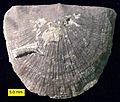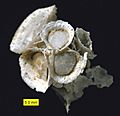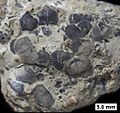Brachiopod facts for kids
Quick facts for kids Brachiopod |
|
|---|---|
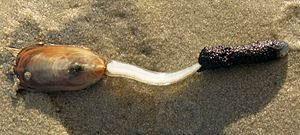 |
|
| Lingula anatina, an inarticulate linguliform brachiopod | |
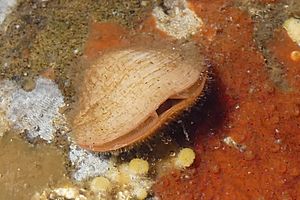 |
|
| Terebratalia transversa, an articulate (rhynchonelliform) brachiopod | |
| Scientific classification |
|
| Kingdom: | Animalia |
| Superphylum: | Lophotrochozoa |
| Clade: | Lophophorata |
| Clade: | Brachiozoa |
| Phylum: | Brachiopoda Duméril, 1806 |
| Subphyla and classes | |
|
See taxonomy |
|
| Diversity | |
| About 100 living genera About 5,000 fossil genera |
|
Brachiopods are a group of small ocean animals that look like shellfish. They are often called lampshells because some of their shells look like old oil lamps. Today, you don't see many brachiopods. But long, long ago, during the Palaeozoic Era, they were very common!
They used to live in shallow water near the shore. Over time, bivalve molluscs (like clams and oysters) became more common. These bivalves competed with brachiopods for space and food. Because of this, brachiopods now mostly live in deeper parts of the ocean.
Contents
What's in a Name? The Story of Brachiopods
The name "brachiopod" comes from two old Greek words. "Brachion" means "arm," and "podos" means "foot." This name describes how they look. Many people also call them "lamp shells." This is because the curved shells of a group called Terebratulida look like old pottery oil-lamps.
How Brachiopods Are Built
Modern brachiopods can be tiny, about 1 millimeter (mm) long, or quite large, up to 100 mm long. Most species are usually around 10 to 30 mm. The biggest living brachiopod is Magellania venosa.
Even though they look a bit like bivalves, their insides are very different. Brachiopods have shells made mostly of calcium carbonate. They have an upper shell and a lower shell. Bivalves, on the other hand, have a left shell and a right shell.
Brachiopod shells are connected at the back with a hinge. They can open the front of their shells to eat. They can also close them tightly for protection.
Scientists divide brachiopods into two main groups: articulate and inarticulate.
- Articulate brachiopods have hinges with "teeth" that help their shells fit together. They have simple muscles to open and close their shells.
- Inarticulate brachiopods have hinges without teeth. They use a more complex set of muscles to move their shells.
Many brachiopods have a stalk-like part called a pedicle. This pedicle comes out of a hole in one of their shells. It helps the animal attach itself to the seabed. This keeps them safe from silt (mud or sand) that could block their opening.
Life Cycle of Brachiopods
Brachiopods can live for a short time, about three years, or for a very long time, over thirty years!
The young (called larvae) of inarticulate brachiopods look like tiny versions of the adults. They have special feeding parts that let them eat and swim for many months. They keep swimming until they get heavy enough to settle down on the seabed.
The larvae of articulate species are different. They don't look like the adults at all. They look more like small blobs with yolk sacs (like a food supply). They only stay in the water for a few days. Then, they change shape (this is called metamorphosis) and settle onto the seabed.
Where Brachiopods Live
Brachiopods only live in the ocean; you won't find them in freshwater. Most brachiopods prefer quiet places without strong currents or big waves. You can often find them in rocky areas, like under ledges, in cracks, or inside caves. They also live on steep slopes of continental shelves and on deep ocean floors.
However, some articulate species can attach themselves to kelp (a type of seaweed). A few even live in very calm spots in the intertidal zone (the area between high and low tide).
The smallest living brachiopod is Gwynia, which is only about 1 mm long. It lives hidden between grains of gravel.
Rhynchonelliform brachiopods have larvae that use up their yolk and settle quickly. These brachiopods often live only in certain areas (they are endemic). They can form very crowded groups, with thousands of individuals in just one square meter! Young brachiopods often attach themselves to the shells of older ones.
Inarticulate brachiopods are different. Their larvae swim for up to a month before settling. This helps them spread out over large areas. For example, members of the genus Pelagodiscus can be found all over the world.
Brachiopods and Other Animals
Sometimes, you can see marks on brachiopod shells that show they were attacked by predators. But often, the shell shows signs that the brachiopod repaired itself! It seems that fish and crabs don't really like the taste of brachiopod meat.
In places where food is hard to find, a snail called Capulus ungaricus will sometimes steal food from other animals, including brachiopods.
Only one type of brachiopod, the lingulids, has ever been caught for food. This has only happened on a very small scale. People mostly eat the fleshy pedicle (the stalk) of these brachiopods.
Brachiopods usually don't settle on man-made surfaces. This is probably because they are sensitive to pollution.
Brachiopods in the Fossil Record
During their peak in the Palaeozoic era, brachiopods lived in many different ocean environments. They were some of the most common animals that filtered food from the water. They also helped build reefs. Many brachiopods stayed on the sea floor, but some could even swim like scallops, using a jet-propulsion style.
Brachiopod fossils are very helpful for understanding past climate changes. For example, during the Ordovician period, when global temperatures were low, the temperature difference between the equator and the poles was huge. This led to different types of brachiopod fossils being found at different latitudes. But during warmer times, like much of the Silurian period, the temperature differences were smaller. This meant the same few brachiopod species could live in all the low to middle latitude seas.
The fossil record also shows that predators like snails and sea urchins attacked molluscs and echinoids much more often than they attacked brachiopods. This suggests that these predators might have attacked brachiopods by mistake, or only when their usual prey was scarce.
Cool Facts About Brachiopods
- Brachiopods are the state fossil of Kentucky in the U.S.
- Brachiopods have a very slow metabolic rate, meaning their bodies use energy slowly.
- The largest known brachiopods, Gigantoproductus and Titanaria, could be 30 to 38 centimeters (about 12 to 15 inches) wide! They lived during the Lower Carboniferous period.
- Today, there are about 100 to 350 living species of brachiopods. But we know of about 12,000 fossil species!
- Lingula is one of the oldest types of brachiopods. It has been around since the earliest Ordovician period and is still alive today.
- The different species of Lingula look very similar. This makes Lingula a great example of a living fossil – an animal that has changed very little over millions of years.
- Scientists called invertebrate palaeontologists are still discussing how to best classify brachiopods.
Gallery
See also
 In Spanish: Brachiopoda para niños
In Spanish: Brachiopoda para niños
- Taxonomy of the Brachiopoda
- Evolution of brachiopods
- List of brachiopod genera
- List of brachiopod species
- Novocrania anomala
- Margaret Jope





